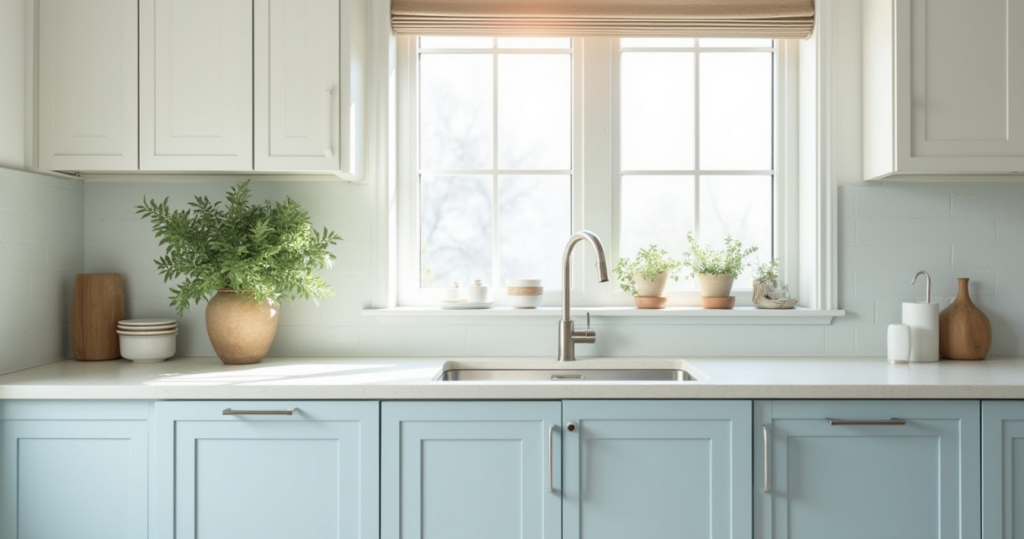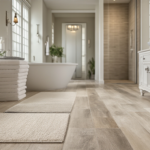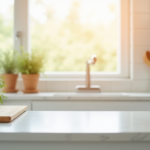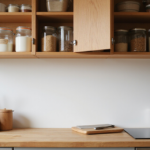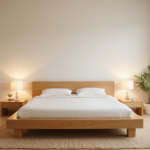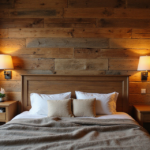Picture walking into your kitchen each morning and feeling an instant wave of calm wash over you. The rich navy cabinets catch the early light streaming through your windows, their depth creating shadows that dance across carefully chosen marble countertops. This isn’t just a fantasy—it’s the transformative power of thoughtfully designed blue kitchen cabinets.
While white and gray have dominated kitchen trends for years, blue emerges as the sophisticated rebel that offers both timeless elegance and refreshing personality. From the gentle serenity of powder blue to the commanding presence of deep navy, blue connects us to nature’s most calming elements—endless skies and tranquil waters—bringing that same sense of peace into the heart of your home.
The beauty of blue kitchen cabinets lies not just in their visual appeal, but in their remarkable versatility. A soft robin’s egg blue can make a cramped galley feel twice its size, while a bold navy island becomes the sophisticated anchor that grounds an entire open-concept space. The key is understanding how different shades interact with light, materials, and your personal style to create something truly extraordinary.
Ready to discover how the perfect shade of blue can revolutionize your kitchen? We’ve curated 22 creative approaches that go far beyond simply painting cabinets blue, exploring everything from strategic color placement to the art of balancing bold hues with complementary materials.
1. Embrace Calm: Why Blue Cabinets Soothe Your Kitchen Space
Blue possesses an almost magical ability to transform the energy of a kitchen from chaotic to composed. Color psychology research consistently links blue to feelings of tranquility and security—it’s the visual equivalent of a deep breath. When you incorporate blue kitchen cabinets into your space, you’re not just choosing a color; you’re creating an environment where meal preparation becomes meditation and family gatherings feel naturally relaxed rather than frenzied.
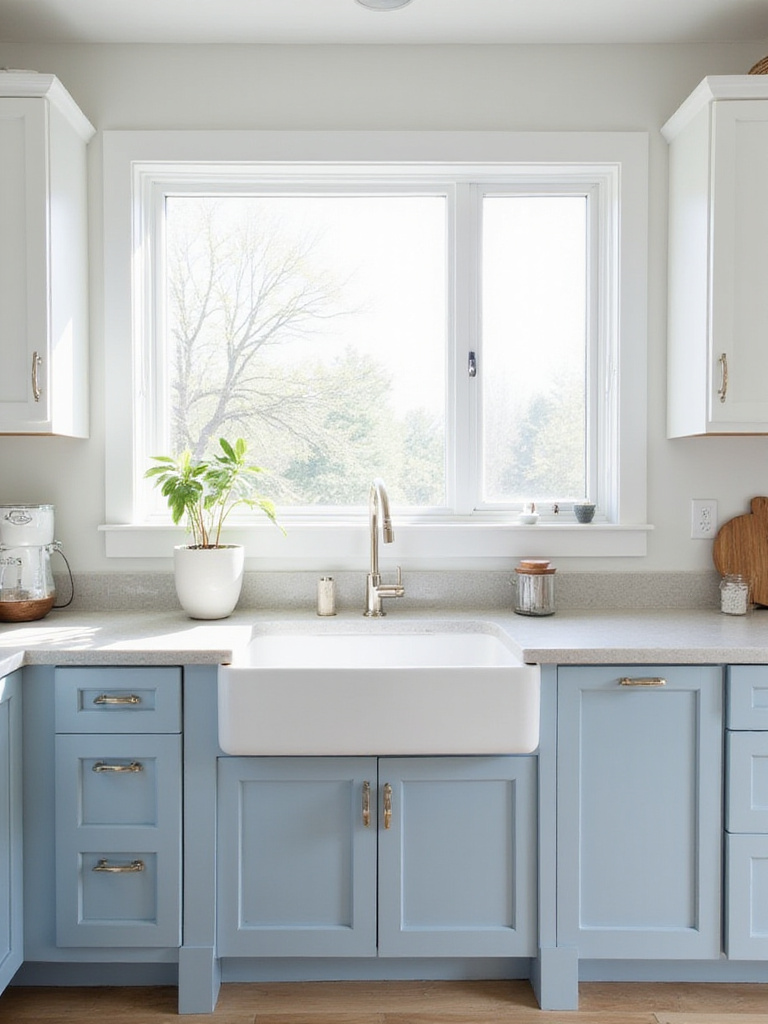
The physiological effects run deeper than mere perception. Studies suggest that exposure to blue can actually slow heart rate and breathing, creating a direct connection between your cabinet choice and your body’s stress response. To harness this calming power effectively, pair your blue cabinets with warm, natural elements like wood countertops or brass hardware. The key lies in balance—let the blue provide the serene foundation while warmer tones prevent the space from feeling sterile or cold.
The magic of blue lies in its incredible range of moods—each shade tells its own story.
2. Find Your Shade: Choosing the Perfect Blue Hue for Mood
Selecting the right blue for your kitchen cabinets is like choosing the emotional soundtrack for your daily life. A soft powder blue whispers tranquility, perfect for busy families seeking refuge from hectic schedules. Meanwhile, a deep navy commands attention with sophisticated gravitas, ideal for those who entertain frequently or simply appreciate dramatic elegance. The intensity of your chosen blue fundamentally shapes how your kitchen feels—and how you feel within it.

Color consultant Karen Haller emphasizes that lighting conditions dramatically affect how blue appears throughout the day. Northern light tends to cool blues, making them appear more gray or green, while southern exposure warms them, bringing out any underlying purple or teal undertones. This means your perfect blue might look completely different in a showroom than in your actual kitchen, making in-home testing absolutely essential for achieving the mood you envision.
For those seeking maximum sophistication, navy blue offers unparalleled elegance.
3. Go Navy: Achieve Classic Elegance with Deep Blue Cabinets
Navy blue has earned its reputation as the “new neutral” in kitchen design, offering the depth and richness of a dramatic color while maintaining the versatility of a classic choice. Unlike stark black, which can feel harsh, or bright white, which shows every fingerprint, navy provides a sophisticated foundation that actually improves with age and use. The key to navy’s enduring appeal lies in its ability to ground a space with authority while remaining surprisingly adaptable to different design styles and seasonal updates.
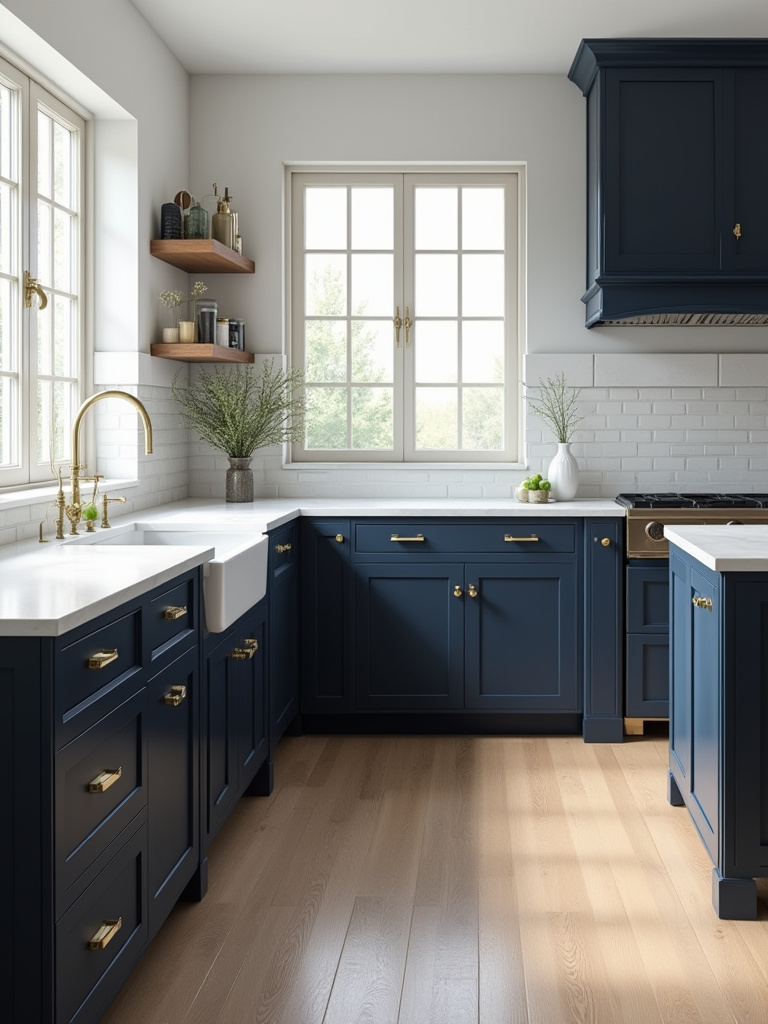
The secret to successful navy blue kitchen cabinets lies in creating strategic contrast. Pair them with crisp white countertops to prevent the space from feeling heavy, and incorporate warm metallic hardware like brushed brass or copper to add inviting warmth. Under-cabinet lighting becomes crucial with darker cabinets—it not only provides essential task illumination but also creates a subtle glow that prevents the navy from overwhelming the space, especially during evening hours when natural light fades.
Beyond the drama of deep blues, lighter shades offer their own compelling advantages.
4. Brighten Up: Using Light Blue for an Airy, Spacious Feel
Light blue kitchen cabinets function like architectural magic, using color psychology to visually expand your space while flooding it with a sense of openness. These pale, ethereal shades reflect rather than absorb light, bouncing illumination around the room and creating the illusion of expanded square footage. It’s particularly transformative in galley kitchens or spaces with limited natural light, where darker colors might create an unwelcome cave-like atmosphere.

The science behind this effect relates to how our eyes perceive receding versus advancing colors. Light blues naturally recede, making walls and cabinets appear further away than they actually are. To maximize this spacious feeling, choose pale, desaturated blues like robin’s egg or soft sky blue, and pair them with equally light countertops and backsplashes. A semi-gloss finish amplifies the light-reflecting properties, creating an almost luminous quality that makes even the smallest kitchen feel bright and welcoming.
What makes this design approach special is the way complex blue shades create unexpected spatial depth.
5. Add Depth: Explore Teal or Grey-Blue Cabinet Options
Moving beyond predictable blues opens up a world of sophisticated color possibilities that add genuine complexity to your kitchen design. Teal and grey-blue shades possess an almost chameleon-like quality, shifting between blue, green, and gray depending on the lighting and surrounding materials. This color-changing nature creates visual depth that makes your kitchen feel larger and more layered than single-note hues could achieve, while offering a more unique and personalized aesthetic than standard navy or powder blue.
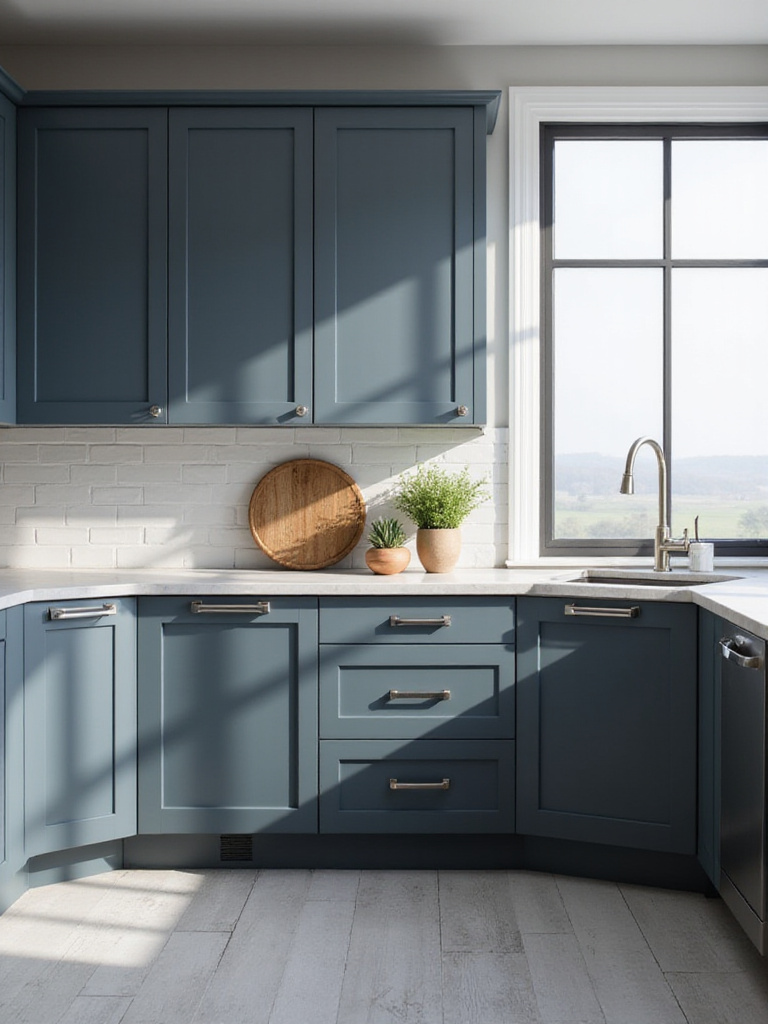
These complex blues work particularly well in kitchens with interesting architectural features or varied lighting conditions. A deep slate-blue might appear almost purple in morning light, shift to true blue at midday, and take on gray undertones in the evening—creating a kitchen that literally evolves throughout the day. The key to success with these sophisticated shades lies in embracing their changeable nature rather than fighting it, choosing complementary materials that enhance rather than compete with the color’s natural variations.
The composition comes together when you anchor your design around a single, powerful focal point.
6. Anchor Your Space: Designing Around a Bold Blue Island
A striking blue kitchen island serves as both functional workspace and artistic statement, creating a powerful focal point that organizes the entire kitchen’s visual hierarchy. This approach allows you to introduce bold color without overwhelming the space, since the island exists as a distinct piece of furniture within the larger room. The surrounding cabinetry can remain neutral, letting the blue island command attention while maintaining overall balance and flow throughout the kitchen.
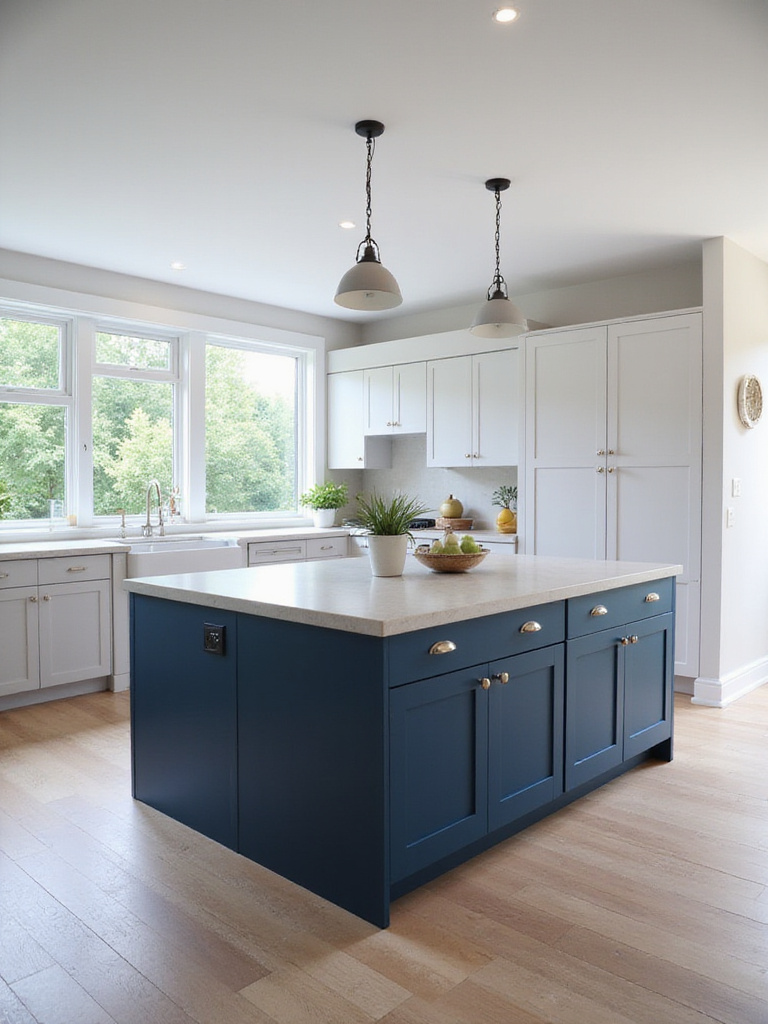
The strategic advantage of a blue island lies in its flexibility—it provides maximum visual impact while offering an easy update path for future design changes. Unlike full blue cabinetry, which represents a significant commitment, a blue island can be repainted or replaced without disrupting the entire kitchen. Choose a shade that complements your existing finishes while being bold enough to justify its starring role. Deep navy, rich teal, or even a sophisticated slate blue work beautifully when paired with warm wood countertops and carefully chosen pendant lighting.
The visual weight balances perfectly when you ground your space with strategic color placement.
7. Grounding Effect: Opting for Blue Lower Cabinets Only
Using blue exclusively on lower cabinets creates a sophisticated design principle known as visual grounding—establishing a strong, stable foundation while maintaining lightness above. This approach mirrors nature’s own color patterns, where deeper tones appear at ground level while lighter shades dominate the sky. The psychological effect is profound: your kitchen feels both substantial and airy, anchored yet open, creating an ideal balance for daily living.
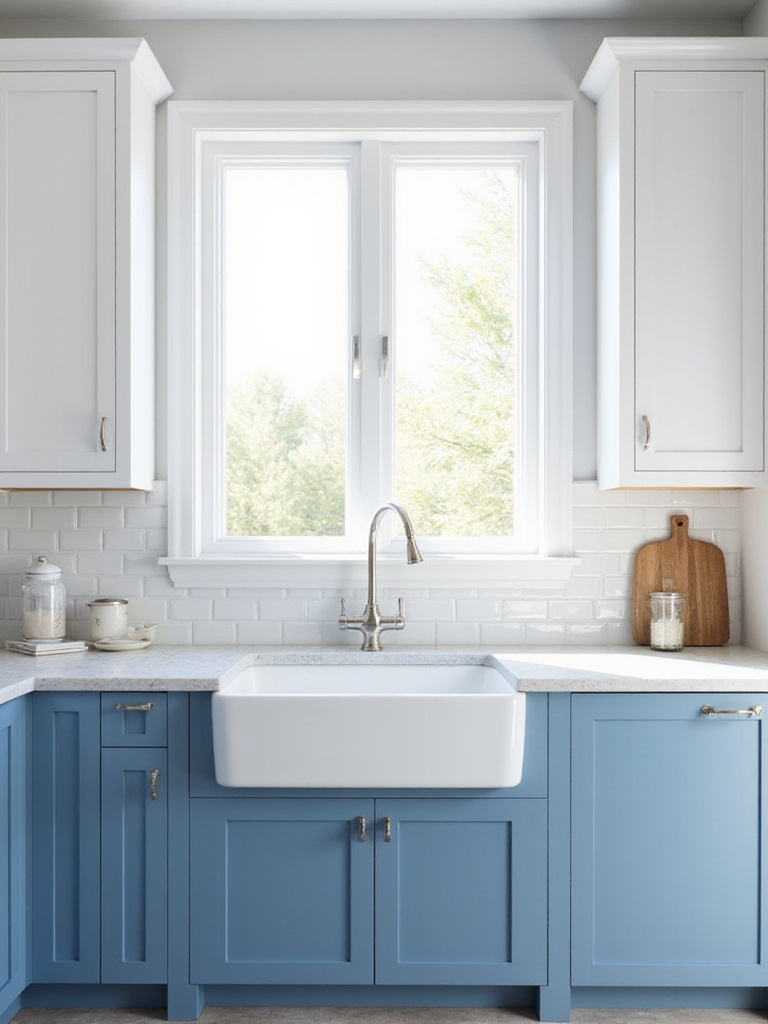
This two-tone strategy offers practical advantages beyond aesthetics. Lower cabinets endure more wear from daily use, and darker blues naturally hide scuffs, fingerprints, and minor dings better than lighter colors. Meanwhile, keeping upper cabinets light prevents the feeling of walls closing in overhead. The contrast also allows you to play with different hardware finishes—perhaps warm brass on the blue lowers and cooler nickel on the white uppers—adding another layer of visual interest to your design.
The finishing touch that elevates the entire look comes from selecting hardware that creates intentional contrast.
8. Hardware Harmony: Selecting Finishes That Pop on Blue
The relationship between blue kitchen cabinets and hardware finishes operates like a carefully orchestrated dance between color and metal, where the right combination can elevate your entire kitchen from beautiful to breathtaking. Warm metals like brass and copper create stunning contrast against cool blues, introducing a luxurious, almost jewelry-like quality that catches and reflects light throughout the day. Meanwhile, matte black hardware offers crisp, modern contrast that works particularly well with lighter blue shades, creating clean lines that feel both contemporary and timeless.
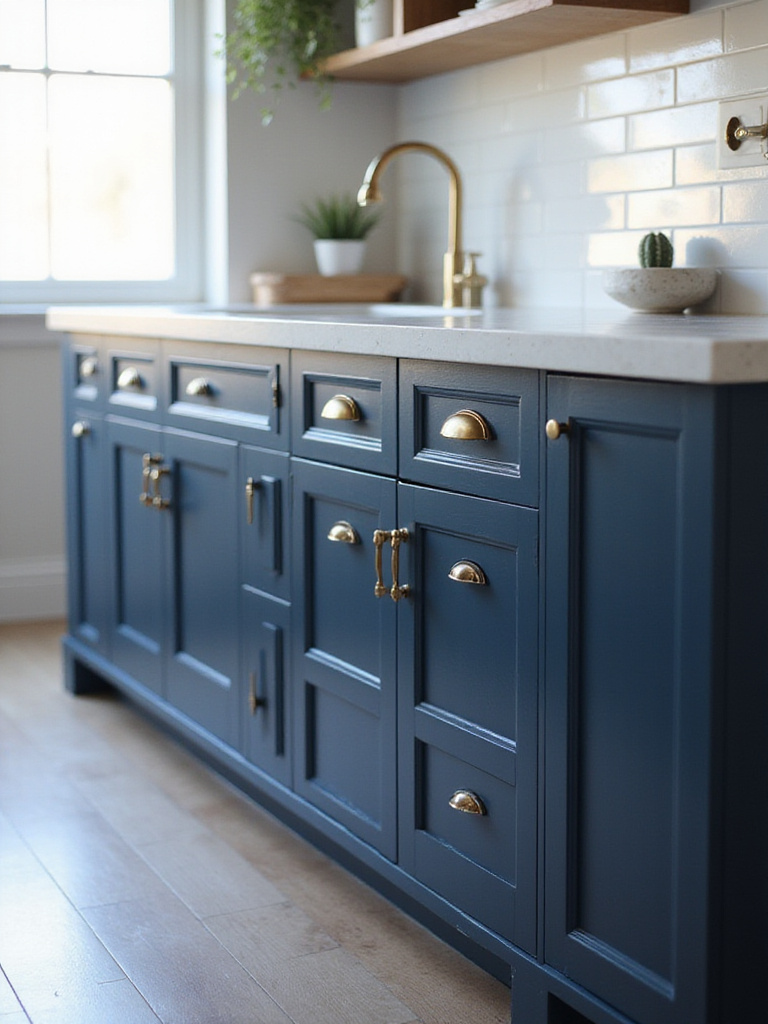
The scale and style of your hardware should complement both your cabinet style and the intensity of your blue choice. Deep navy cabinets can handle substantial, dramatic pulls that might overwhelm lighter shades, while pale blue cabinets often look best with more delicate, refined hardware. Consider the other metallic elements in your kitchen—faucets, lighting fixtures, appliance finishes—to ensure your hardware choice creates intentional coordination rather than accidental competition.
The unexpected pairing that always works involves thoughtful countertop selection that enhances your blue cabinets.
9. Countertop Chemistry: Best Pairings for Blue Cabinets
The countertop you choose for your blue kitchen cabinets creates either harmony or dynamic contrast, fundamentally shaping the kitchen’s personality and functionality. White quartz and marble remain popular choices because they provide crisp, clean contrast that brightens the entire space while allowing the blue to truly shine. The veining in natural marble adds organic movement that softens the geometric lines of cabinetry, creating visual interest without competing for attention.
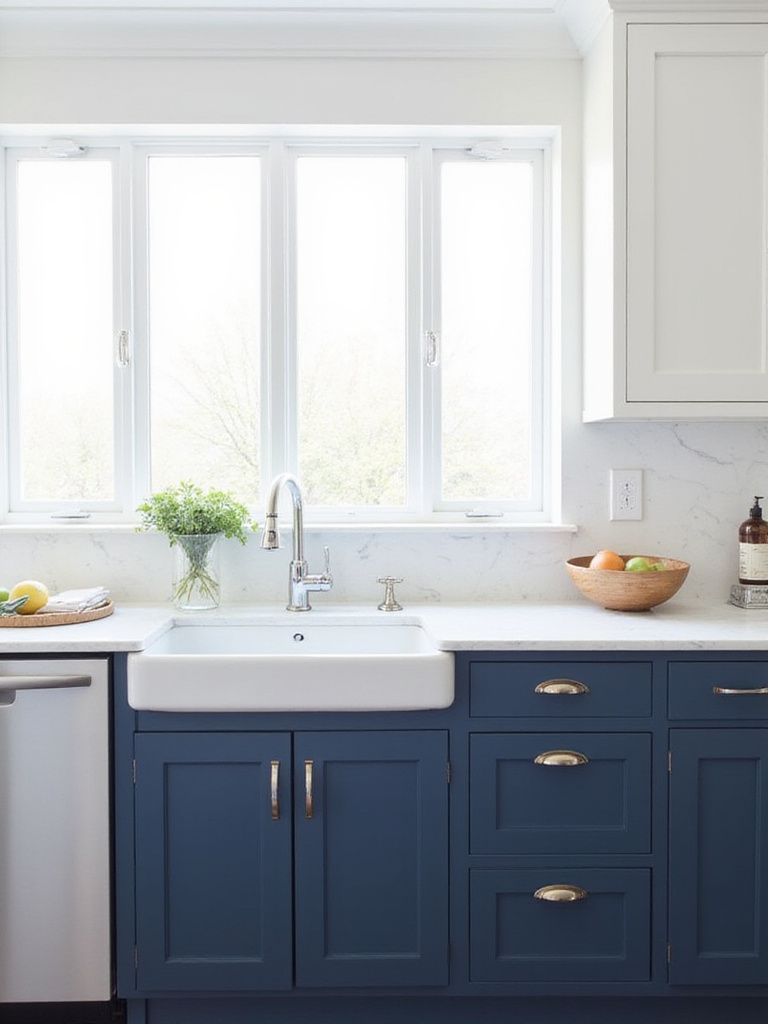
For those seeking warmth and texture, consider butcher block or natural wood countertops that introduce organic elements to balance the coolness of blue. This combination works particularly well in farmhouse or transitional kitchens, where the interplay between cool and warm tones creates inviting, livable spaces. Darker countertops like granite or soapstone can work beautifully with lighter blue cabinets, but require careful consideration of lighting to prevent the space from feeling too heavy or closed-in.
The styling mistake most people make is overlooking how backsplash selection can make or break the entire design.
10. Backsplash Brilliance: Ideas to Complement Blue Cabinetry
Your backsplash serves as the visual bridge between blue kitchen cabinets and countertops, offering an opportunity to introduce texture, pattern, or subtle color variation that enhances the overall design story. Classic white subway tile provides timeless contrast that allows blue cabinets to take center stage, while the subtle shadows created by beveled edges add depth and movement. For those seeking more drama, consider extending your backsplash material all the way to the ceiling, creating a striking focal wall that makes the space feel taller and more custom.
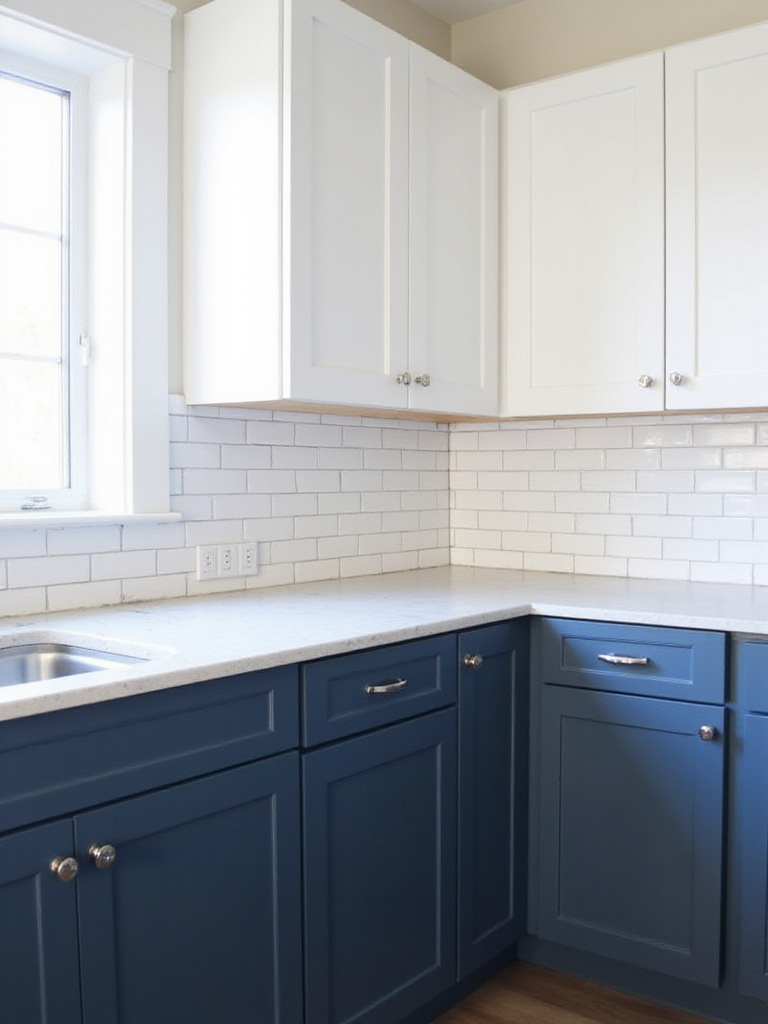
Natural materials like zellige or handmade ceramic tiles introduce organic imperfections that soften the precision of painted cabinets, adding warmth and character to the space. The slight color variations inherent in handcrafted tiles create visual interest without overwhelming bold blue cabinets. Metallic accents—whether through mosaic inserts, decorative borders, or even copper or brass tiles—can echo your hardware finish and create cohesive design flow throughout the kitchen.
The environmental story behind this choice becomes even more compelling when you consider wall color selection.
11. Wall Color Wisdom: Painting Schemes That Enhance Blue
The wall color you choose creates the emotional backdrop for your blue kitchen cabinets, either amplifying their beauty or accidentally diminishing their impact. Warm neutrals like soft greige or creamy whites prevent blue cabinets from feeling cold while adding sophisticated depth to the overall palette. These colors work particularly well in kitchens with northern exposure, where natural light tends to emphasize cool undertones, potentially making pure blues appear harsh or unwelcoming.
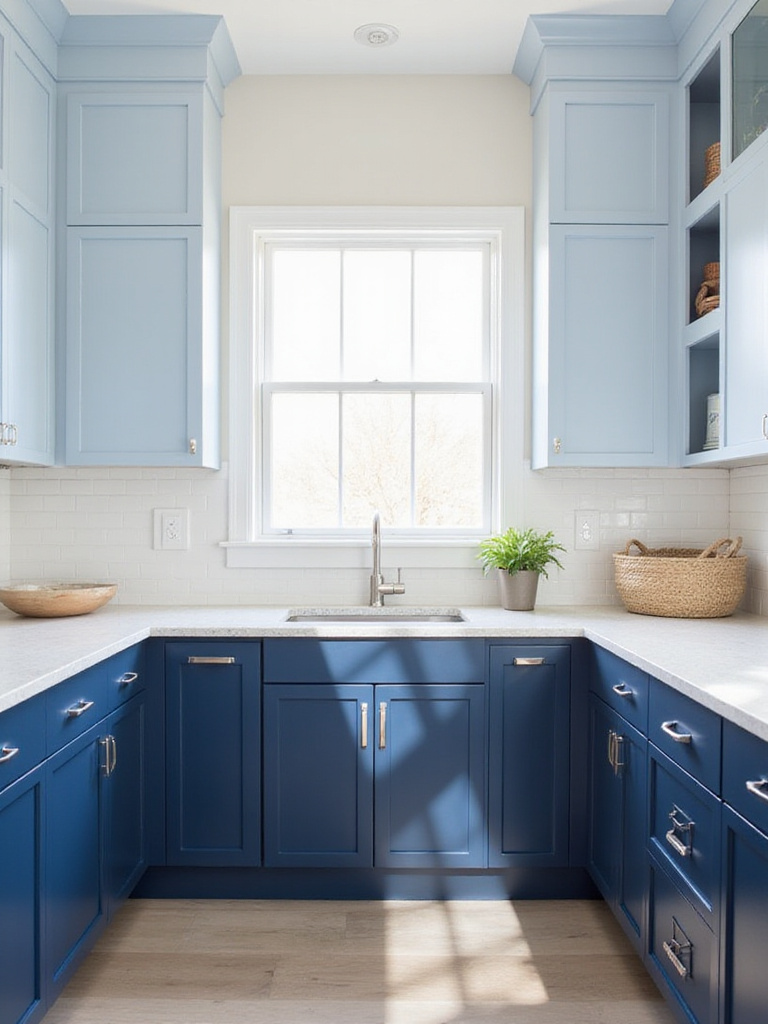
Understanding undertones becomes crucial when selecting wall colors for blue cabinets. A blue with green undertones pairs beautifully with warm whites that have slight yellow or peach bases, while purple-leaning blues look stunning against cooler whites with gray or blue undertones. The key lies in testing large paint samples in your actual kitchen lighting, observing how the colors interact throughout the day as natural light shifts and evening lighting takes over.
The foundation matters tremendously, and flooring choice can make or break your blue cabinet design.
12. Flooring Foundations: Choosing the Right Base for Blue
Your flooring choice provides the literal foundation for blue kitchen cabinets, influencing everything from the perceived warmth of the space to how the blue color appears to your eye. Warm wood tones create beautiful contrast with cool blues, preventing the kitchen from feeling sterile while adding natural texture that grounds the space. Light oak or maple floors brighten the entire room, while richer walnut or cherry tones add sophisticated depth that complements deeper blue shades.

The durability factor becomes particularly important in kitchens, where spills, dropped items, and heavy foot traffic are daily realities. Luxury vinyl plank (LVP) and engineered hardwood offer excellent performance while providing the visual warmth of natural wood. For those preferring tile, large-format porcelain in wood-look or stone patterns can provide the aesthetic appeal of natural materials with superior water resistance and easier maintenance than traditional options.
For clients who ask us about creating contemporary spaces, blue cabinets offer unexpected versatility.
13. Modern Edge: Creating a Sleek Blue Kitchen Look
Achieving a truly modern aesthetic with blue kitchen cabinets requires embracing minimalist principles while using color strategically to create visual impact. Flat-panel or slab-style cabinet doors eliminate unnecessary ornamentation, allowing the blue color itself to become the primary design element. Matte finishes enhance this contemporary approach by eliminating reflective surfaces that might feel too traditional or busy, instead creating smooth, sophisticated planes of color that feel both bold and serene.
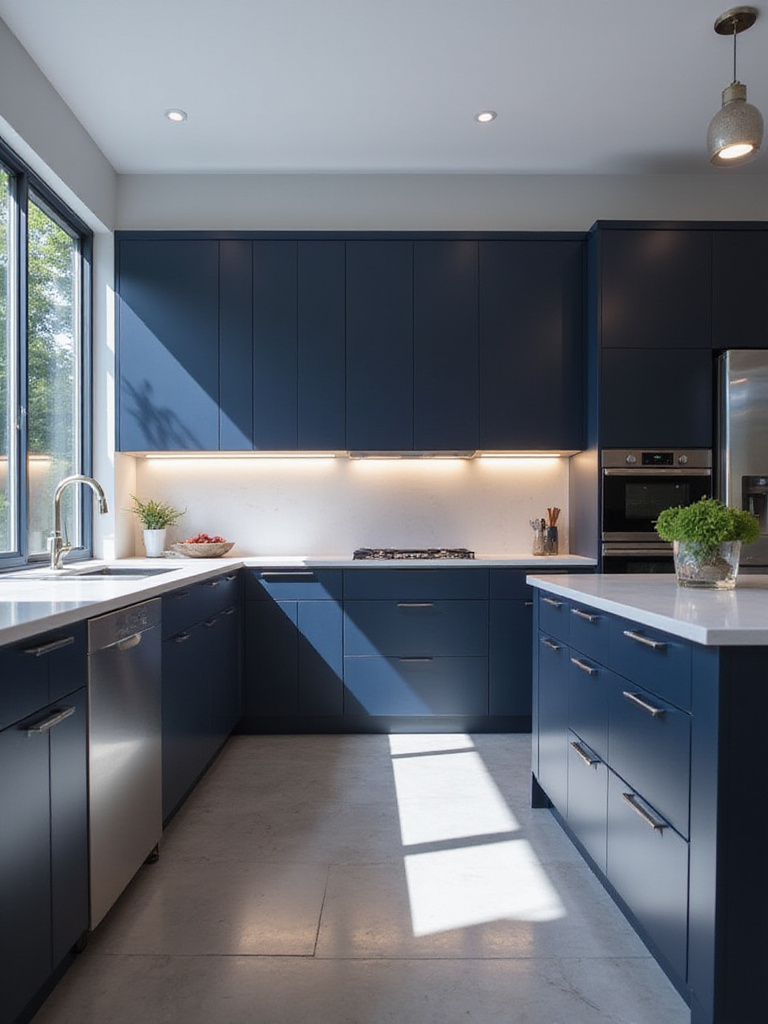
The key to modern blue kitchens lies in restraint and precision. Choose hardware that disappears into the design—integrated finger pulls or ultra-slim bar handles in matching or contrasting finishes. Pair your blue cabinets with equally clean-lined countertops like solid quartz or concrete, and consider a minimalist backsplash approach using large-format tiles or even painted glass. The goal is creating a space where every element feels intentional and necessary, with blue providing personality within a framework of sophisticated simplicity.
The heritage technique gets a contemporary update through traditional design principles that never go out of style.
14. Timeless Charm: Designing Traditional Blue Cabinet Kitchens
Traditional kitchens with blue cabinets offer a perfect marriage of classic elegance and personal expression, creating spaces that feel both historically grounded and refreshingly individual. Blue has deep roots in traditional design—from Dutch Delft pottery to colonial American paint colors—making it a natural choice for kitchens that celebrate craftsmanship and enduring style. The key lies in choosing blues that feel authentic to traditional palettes: think deep navy, dusty colonial blue, or soft gray-blue shades that might have been mixed with natural pigments centuries ago.

Shaker-style cabinet doors provide the perfect canvas for traditional blue kitchens, offering clean lines that feel neither too ornate nor too stark. Pair them with classic materials like marble or granite countertops, subway tile backsplashes, and traditional hardware in brushed nickel or antique brass. The beauty of traditional blue kitchens lies in their ability to feel both familiar and fresh—honoring design history while creating spaces that feel thoroughly livable for modern families.
The unexpected environmental benefit comes from choosing blue cabinets that naturally connect to coastal living.
15. Coastal Vibes: Bringing Beach Style with Blue Cabinets
Blue kitchen cabinets provide the perfect foundation for coastal-inspired design, naturally evoking the calming presence of ocean and sky while creating spaces that feel perpetually vacation-ready. The connection between blue and coastal living runs deeper than simple color association—it taps into our psychological need for tranquility and escape, transforming everyday cooking and dining into more relaxed, enjoyable experiences. Lighter blues like aqua or seafoam create bright, airy spaces reminiscent of beach cottages, while deeper navy tones channel sophisticated nautical style.

The magic of coastal blue kitchens lies in layering natural textures and materials that enhance the oceanic feeling. Consider pairing blue cabinets with butcher block countertops for warmth, white or cream subway tiles for that classic beach house feel, and natural fiber accessories like jute or rope details. Brushed nickel or chrome hardware echoes the reflective quality of water, while strategic use of white and cream prevents the blue from overwhelming the space. The goal is creating a kitchen that feels like a seaside retreat, regardless of your actual proximity to the coast.
The challenge of smaller budgets becomes easier when you focus on strategic updates rather than complete overhauls.
16. Budget-Friendly Blue: Achieving the Look Without Overspending
Creating stunning blue kitchen cabinets doesn’t require a complete renovation or professional contractor—strategic DIY updates can deliver dramatic transformation for a fraction of the cost. Cabinet painting represents one of the highest-impact, lowest-cost improvements you can make, potentially saving 50-70% compared to cabinet replacement while achieving professional-looking results. The key lies in proper preparation: thorough cleaning, careful sanding, and high-quality primer create the foundation for a durable, beautiful finish that rivals factory-painted cabinets.

Focus your budget on elements that deliver maximum visual impact. Painting just the lower cabinets or kitchen island in blue while keeping uppers neutral creates dramatic contrast without overwhelming your budget or the space. Updating hardware provides another high-impact, low-cost improvement—modern pulls and knobs can make even budget-painted cabinets look custom and expensive. Consider shopping end-of-season sales for hardware, or explore online retailers for designer-look options at fraction of showroom prices.
The artisan’s journey from apprentice to master influenced the techniques needed for successful DIY cabinet painting.
17. DIY Dive: Tips for Painting Cabinets Blue Yourself
Successfully painting kitchen cabinets blue requires understanding that preparation accounts for 80% of the final result—a truth that separates professional-looking DIY projects from disappointing amateur attempts. Begin by thoroughly degreasing all surfaces with TSP (trisodium phosphate) or a strong degreasing cleaner, paying special attention to areas around handles and the stove where cooking residue accumulates. Remove all doors and drawers, labeling each piece clearly to ensure easy reassembly, and set up a dedicated workspace with proper ventilation and lighting for the painting process.

The choice of paint makes an enormous difference in both application ease and long-term durability. Cabinet-specific paints or high-quality acrylic-alkyd hybrid enamels provide superior adhesion and durability compared to standard wall paints. Apply thin, even coats rather than trying to achieve full coverage in one pass—two or three light coats create a smoother, more professional finish than one thick application. Consider investing in a small foam roller or paint sprayer for the smoothest possible finish, especially on flat-panel doors where brush marks would be highly visible.
The sustainable journey of maintaining your investment begins with proper care techniques.
18. Keep it Clean: Maintaining the Beauty of Blue Cabinets
Preserving the vibrant beauty of blue kitchen cabinets requires understanding that prevention trumps correction every time—immediate attention to spills and splatters prevents staining and finish damage that can be difficult or impossible to reverse. The key lies in developing simple daily habits: wiping down cabinet fronts with a slightly damp microfiber cloth after cooking, paying special attention to areas around the stove and sink where grease and moisture naturally accumulate. This gentle daily maintenance prevents the buildup that requires harsh cleaning methods later.

For deeper cleaning, avoid the temptation to use strong degreasers or abrasive cleaners that can damage painted finishes. Instead, mix a few drops of mild dish soap in warm water, clean with a soft cloth following the grain direction, and immediately dry with a clean towel to prevent water spots. For stubborn grease buildup, a paste made from baking soda and water provides gentle abrasive action without scratching the finish. Place protective mats under small appliances like coffee makers to catch steam and spills that could otherwise damage overhead cabinets.
The emotional response this evokes begins with understanding how lighting transforms blue cabinets throughout the day.
19. Light it Up: Lighting Strategies for Blue Kitchens
Strategic lighting design becomes absolutely crucial with blue kitchen cabinets because light dramatically affects how we perceive color—the wrong lighting can make beautiful blue appear dull, muddy, or even greenish. Layer your lighting approach with three distinct types: ambient lighting for general illumination, task lighting for work areas, and accent lighting to highlight the beauty of your blue cabinets. Warm LED under-cabinet strips (2700K-3000K) make blue cabinets feel rich and inviting, while cooler lighting (3500K-4000K) can make them appear crisp and modern.
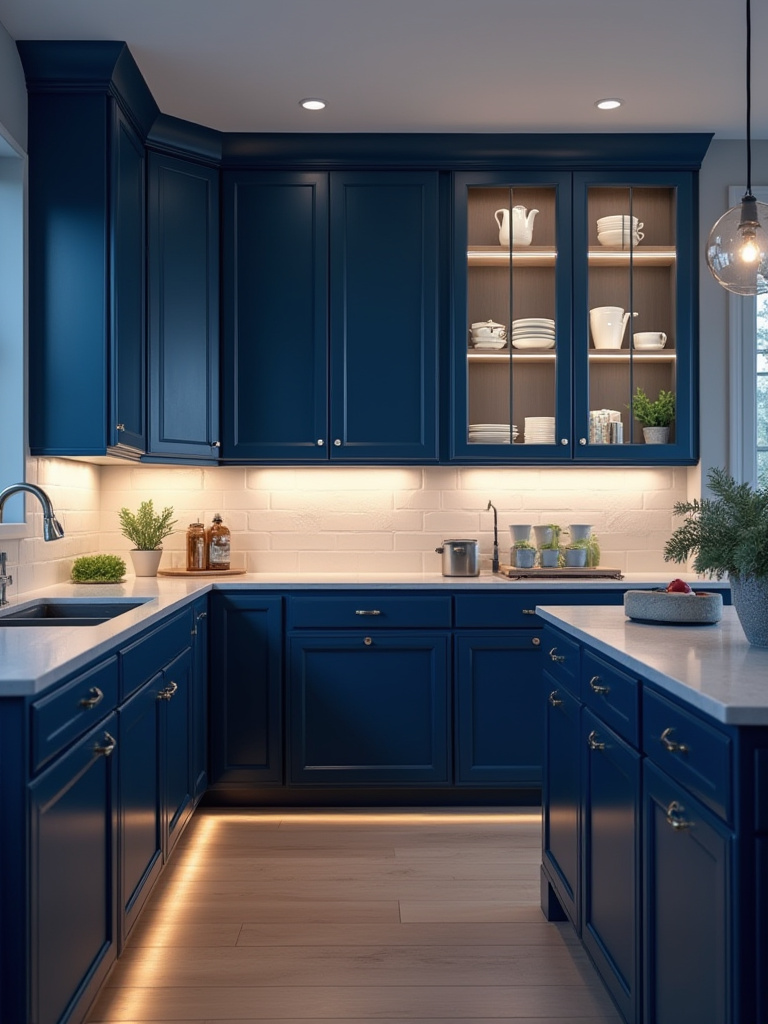
The color temperature of your bulbs should complement, not fight, your specific blue shade. Deeper blues like navy benefit from warmer light temperatures that enhance their richness, while lighter blues often look best under slightly cooler lighting that maintains their fresh, airy quality. Install dimmer switches on key circuits to adjust the mood throughout the day—bright task lighting for food preparation, softer ambient lighting for dining and entertaining. Consider adding LED strip lighting inside glass-front cabinets to create a subtle glow that showcases your dishware while adding another layer of visual interest.
The challenge of overwhelming the space becomes easier when you understand balance principles.
20. Avoid Overwhelm: Preventing Blue from Dominating Your Space
While blue kitchen cabinets create stunning focal points, using too much of any strong color can make a kitchen feel heavy, monotonous, or claustrophobic. The secret lies in treating blue as the star performer in an ensemble cast—it should command attention while being supported by a carefully chosen palette of neutrals and textures. Think of your blue cabinets as the anchor point around which other elements revolve, providing stability and personality without overwhelming the senses or making the space feel unbalanced.
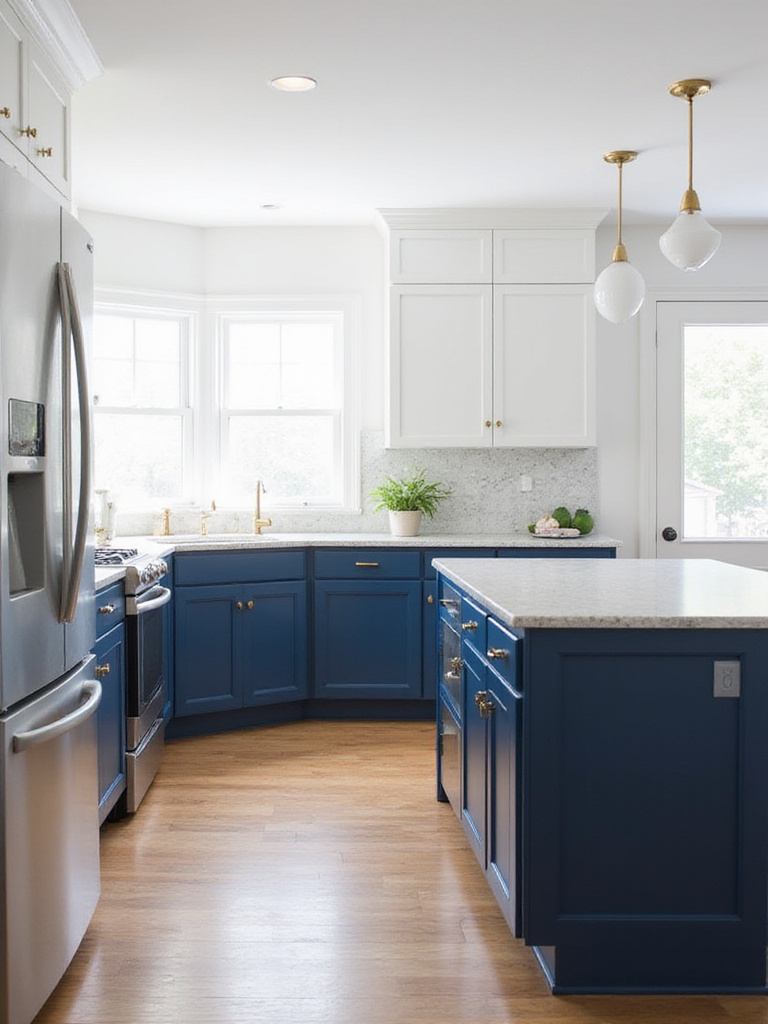
Strategic contrast becomes your most powerful tool for preventing blue overwhelm. Pair deep blue lower cabinets with crisp white uppers to maintain visual lightness above eye level, or use blue exclusively on a kitchen island while keeping perimeter cabinets neutral. Introduce warm-toned materials like natural wood flooring, brass hardware, or butcher block countertops to prevent the space from feeling too cool or sterile. The goal is creating a sophisticated color story where blue provides drama and personality within a framework of balanced, livable design.
When clients ask us about maximizing impact in smaller spaces, blue cabinets offer surprising solutions.
21. Small Kitchen Solutions: Making Blue Work in Compact Areas
Small kitchens can absolutely accommodate blue cabinets with the right strategic approach—the key lies in understanding how different blue shades and finishes interact with light and space perception. Lighter blues naturally make spaces feel larger by reflecting rather than absorbing light, while a high-gloss or semi-gloss finish amplifies this effect by creating subtle light reflection throughout the day. Consider using blue strategically on lower cabinets only, keeping upper cabinets white or light gray to maintain visual openness above eye level.
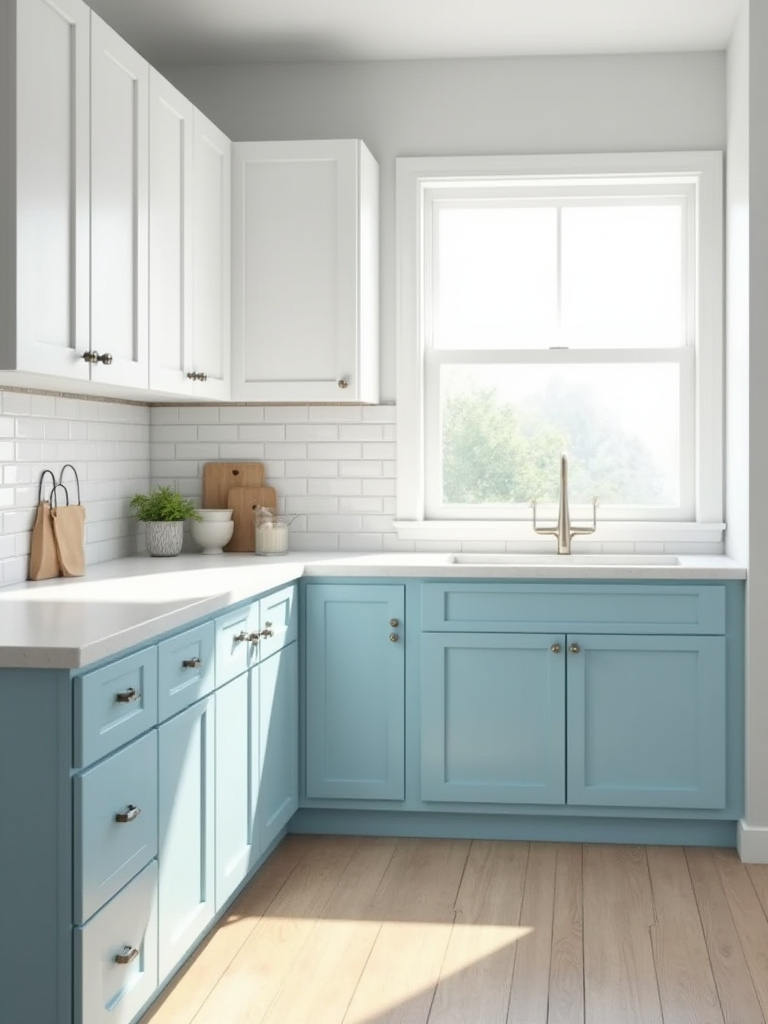
The secret to successful blue in small kitchens involves maximizing every source of light while choosing blue shades that enhance rather than fight your space’s natural characteristics. In galley kitchens, painting just one wall of cabinets blue while keeping the opposite wall neutral can add personality without creating a tunnel effect. Ensure adequate task lighting with LED under-cabinet strips, and consider adding interior cabinet lighting to create depth and visual interest that makes the space feel larger and more sophisticated than its actual square footage suggests.
The forecast for next season already hints at blue’s enduring appeal and timeless qualities.
22. Long-Term Love: Will Blue Cabinets Stand the Test of Time?
Blue kitchen cabinets possess remarkable staying power because they tap into fundamental human connections with nature—sky, water, and natural elements that have provided comfort and inspiration throughout history. Unlike trendy colors that feel dated within a few years, classic blue shades like navy, slate blue, and soft gray-blue have appeared in traditional design for centuries, suggesting their appeal transcends temporary fashion cycles. The key to ensuring your blue cabinets remain timeless lies in choosing sophisticated, nature-inspired shades rather than bright, artificially saturated hues that might feel dated as trends evolve.

Quality becomes paramount when investing in blue cabinets for long-term satisfaction. A well-executed blue kitchen using classic materials—natural stone countertops, traditional hardware finishes, and quality cabinet construction—reads as custom and high-end rather than trendy. Real estate professionals note that thoughtfully designed blue kitchens often enhance rather than detract from home value, particularly when the blue is balanced with neutral elements that appeal to a broad range of tastes. The versatility of blue allows for easy updates through accessories, lighting, and seasonal styling without requiring major renovations.
Conclusion
Designing a kitchen with blue kitchen cabinets opens up a world of creative possibilities that extend far beyond simply choosing a paint color. From the serene tranquility of powder blue to the sophisticated drama of deep navy, each shade offers unique opportunities to create spaces that reflect your personality while enhancing daily life. The 22 approaches we’ve explored demonstrate that blue’s versatility lies not just in its range of hues, but in its ability to adapt to every design style, budget level, and spatial constraint.
The beauty of blue kitchen cabinets lies in their fundamental connection to elements that naturally calm and inspire us—endless skies, tranquil waters, and the peaceful moments we associate with both. Whether you choose to anchor your space with a bold blue island, create airy openness with light blue uppers, or establish sophisticated elegance with navy lowers, you’re tapping into color psychology that makes kitchens feel more welcoming and harmonious.
As you embark on your blue kitchen journey, remember that the most successful designs balance bold color choices with thoughtful material selection, strategic lighting, and careful attention to how all elements work together. Blue kitchen cabinets aren’t just a trend—they’re a timeless choice that can evolve with your style while maintaining their fundamental appeal for years to come.
